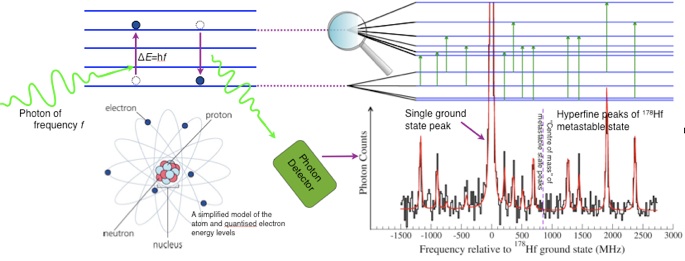Theory

During a laser frequency scan, electrons are excited when a resonance is reached. Photons are absorbed and re-emitted. High resolution spectroscopy reveals the splitting of these spectral lines into the hyperfine structure, caused by the interaction between the electrons and the nucleus. From this analysis, we can determine nuclear properties such as the magnetic moment, quadrupole moment (shape), and nuclear angular momentum quantum number. For the particular element under study, the central position of these structures is offset from one isotope to another. This is known as the isotope shift which can be used the determine the nuclear mean-square charge radius.
Laser spectroscopy is used to investigate a chosen fine structure line between two fine structure levels. These are the energy levels of the electrons once effects such as the atomic spin-orbit coupling are taken into account, and are each denoted by the angular momentum quantum number, J (the coupling of L and S). The nucleus also has an angular momentum, denoted by the quantum number I, and (providing I >1/2) a nuclear magnetic moment. This interacts with the magnetic field produced by the electrons causing a splitting of the levels (and therefore the spectral line) into the hyperfine levels, each denoted by the quantum number F - formed from the coupling of I and J (in the same way that J is formed from L and S). If I >1/2, each of these levels are perturbed as a result of the nuclear electric quadrupole moment interacting with the electric field gradient produced by the electrons. This allows the static quadrupole deformation of the nuclear shape to be determined.

The isotope shift between two isotopes of an element (or between two nuclear states of the same isotope) comprises the mass shift and the field shift. The mass shift accounts for the recoil motion of the nucleus and the effect of the reduced mass on the energy levels. The changing spatial extent of the nucleus also alters the electron energy levels and therefore the relative transition frequencies. This latter effect, the field shift, permits the isolation of the nuclear mean-square charge radius - a fundamental and model independent quantity. However, this can also be used to infer changes not only in the nuclear volume, but the mean-square deformation (sensitive also to the dynamic nature of the deformation) and the nuclear surface diffuseness.
